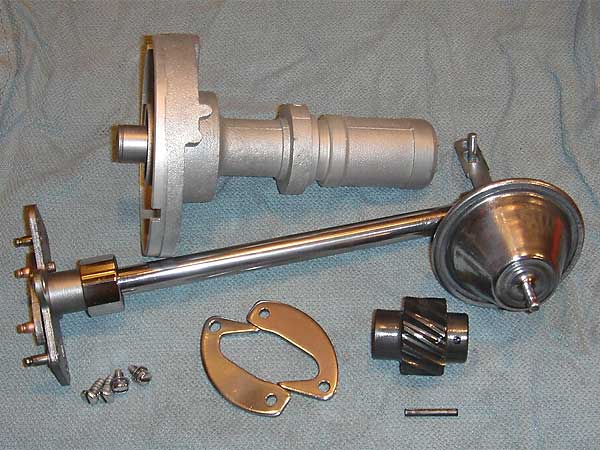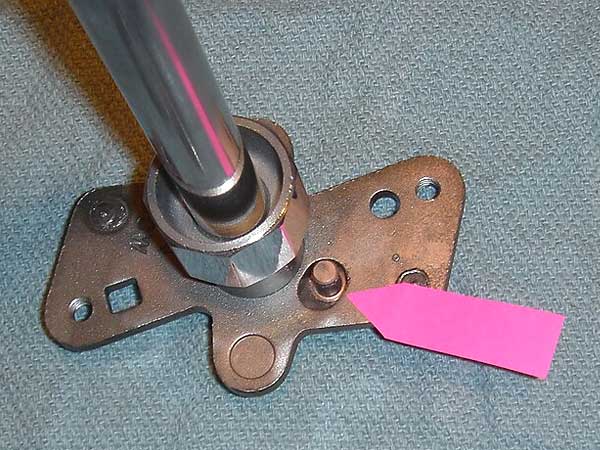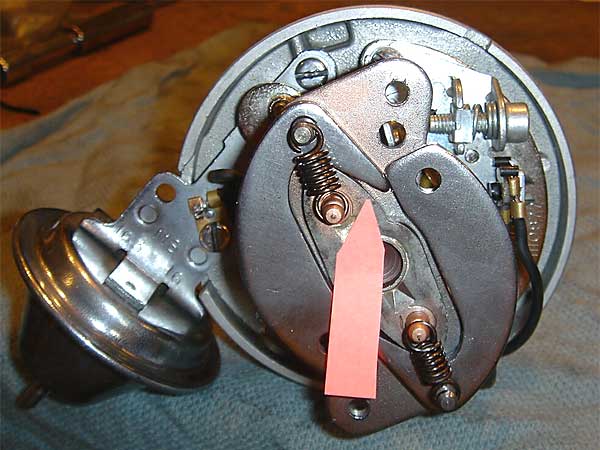
Photo 1: Buick 215 Distributor, Cleaned Up and Torn Down
Mechanical Ignition Advance
as published in British V8 Newsletter, Volume XIV Issue 3, December 2006by: Jeff Schlemmer, proprietor of Advanced Distributors, LLC
For folks who are interested in recurving their own distributor, I'm going to attempt to explain the basics of how to make adjustments and where they are made to achieve a well rounded ignition curve. First things first: you must start with clean, well-lubricated parts! Your ignition curve will never be consistent if pivot points are binding from dried grease or if the bushings are sloppy loose.
Many versions of Rover and Buick distributors have been used over the years. The unit shown in this article came from a 1961 Buick 215. It was not a low mileage engine, and these parts looked like they would never be used again. If you're working with similarly aged components, you'll likely find that the whole works needs to be soaked in penetrant before you'll be able to remove the shaft at all, due to dried oil build-up between the upper and lower bushings.
The amount of total advance offered by any distributor is adjustable, and in
most cases 10-12 degrees of advance will get you in the ballpark. In Photo 2,
the pink arrow highlights the adjustment mechanism (i.e. a pin which moves
within a hole or slot). The width of the hole is the amount of advance that
is allowed. The proper way to change the amount of advance available is to weld
the hole smaller or to grind it larger. A few thousandths of an inch goes a
long way! The hole shown here offers 17 degrees of advance. Obviously, it
would also be technically possible to resize or reshape the pin. More commonly,
when less ignition advance is desired, a bushing is slipped onto the pin and
secured in place with a small circlip. Recurve kits for some models of
distributor include a bushing or two for this purpose, but in the case of this
Buick distributor the pin hangs upside down above the points. I believe it would
be in the best interest of distributor to make a permanent repair, because a
failed clip might result in a destroyed distributor.

Photo 2: Total Ignition Advance Adjustment

Photo 2: Total Ignition Advance Adjustment
The rate of mechanical ignition advance is determined by two important factors
in these distributors. The springs are the most obvious, but the advance cam is
equally important. In Photo 3, the peach colored arrow highlights the curved
ramp that the weights follow as centrifugal force stretches the springs and
allows advance. As the weight rotates across the length of the arched ramp,
the radius of the curve determines the speed of advance onset. If the contact
surface of the ramp starts basically "flat" for the first half of the weight's
travel path, and then has a sharp radius for the second half, you'll get a fast
onset of mechanical timing advance followed by a slow finale. In this case,
however, we find a relatively even radius the entire length, so the curve will
be smooth. This is what I like to see for most street-performance applications!
In some later model distributors, you will find that the advance cam can be
removed and replaced. Some Delco recurve kits offer replacement cams with
different advance rates, or you can weld and grind the existing unit to achieve
virtually any desired results.

Photo 3: Tuning Centrifugal Ignition Advance Mechanisms
The selection of advance springs also affects how the ignition advance curve relates to engine rpm. Replacement springs come in different strengths and lengths, and as a practical matter there can even be significant variability in springs that look quite similar. It's a great convenience to have a lot of springs available. By using a precision spring force measurement tool and also by measuring spring length, springs can be selected that will provide more predictable performance results.
Obviously, the distributor shown here has two springs. It is often desirable to select two springs that are somewhat mismatched. A lighter strength primary spring (primary meaning the first spring to engage) used with a loose fitting but relatively strong secondary spring will allow fast immediate advance at low rpms, but a long, slow second half of the ignition curve. Compare this to a pair of moderate strength matched springs and you can have a difference of 10 crank degrees at mid-advance rpms, even though the start and finish points of the curve stay virtually identical.
The general rule of thumb is that the ignition curve should start just after idle, and be "all-in" around 3000 rpms. There are many factors that change the engine's needs, such as compression ratio, type of carburetion, cylinder head airflow, type and model of camshaft, as well as a long list of factors that need to match the driver's needs such as fuel mileage, choice of transmission (overdrive or not), highway driving, or drag race use.
Remember, when you chose an ignition curve for your engine, you should think of the bigger picture. The amount of distributor advance should be figured from the amount of total advance your engine can handle without losing power or pinging, minus the amount of advance your engine can tolerate at idle. Most drivers want a smooth idle, but others prefer just a little choppiness to show off a high performance cam. Some folks don't care if it idles at all, as long as it screams down the drag strip! A bit of playing with your current distributor can help determine what will work best in your one-of-a-kind car: find the best timing setting at idle, find the best timing setting for above-3000 rpm driving, note the side effects at other rpms if there are any, and with all these details considered you can map your own perfect ignition advance curve.

Photo 3: Tuning Centrifugal Ignition Advance Mechanisms
The selection of advance springs also affects how the ignition advance curve relates to engine rpm. Replacement springs come in different strengths and lengths, and as a practical matter there can even be significant variability in springs that look quite similar. It's a great convenience to have a lot of springs available. By using a precision spring force measurement tool and also by measuring spring length, springs can be selected that will provide more predictable performance results.
Obviously, the distributor shown here has two springs. It is often desirable to select two springs that are somewhat mismatched. A lighter strength primary spring (primary meaning the first spring to engage) used with a loose fitting but relatively strong secondary spring will allow fast immediate advance at low rpms, but a long, slow second half of the ignition curve. Compare this to a pair of moderate strength matched springs and you can have a difference of 10 crank degrees at mid-advance rpms, even though the start and finish points of the curve stay virtually identical.
The general rule of thumb is that the ignition curve should start just after idle, and be "all-in" around 3000 rpms. There are many factors that change the engine's needs, such as compression ratio, type of carburetion, cylinder head airflow, type and model of camshaft, as well as a long list of factors that need to match the driver's needs such as fuel mileage, choice of transmission (overdrive or not), highway driving, or drag race use.
|
Enjoying this article? Our magazine is funded through the generous support of readers like you! To contribute to our operating budget, please click here and follow the instructions. (Suggested contribution is twenty bucks per year. Feel free to give more!) |
Remember, when you chose an ignition curve for your engine, you should think of the bigger picture. The amount of distributor advance should be figured from the amount of total advance your engine can handle without losing power or pinging, minus the amount of advance your engine can tolerate at idle. Most drivers want a smooth idle, but others prefer just a little choppiness to show off a high performance cam. Some folks don't care if it idles at all, as long as it screams down the drag strip! A bit of playing with your current distributor can help determine what will work best in your one-of-a-kind car: find the best timing setting at idle, find the best timing setting for above-3000 rpm driving, note the side effects at other rpms if there are any, and with all these details considered you can map your own perfect ignition advance curve.
But that's only part of the story. Once you have mechanical ignition advance all
figured out, we can move on to vacuum-advance affects on performance and fuel
economy.
Keep in mind that if you decide to recurve your distributor, there are many, many decisions to be made and just as many adjustments. Patience will be of the utmost importance. Many adjustments may need to be made several times before they are perfect. If you think that making any of these repairs or curve decisions is out of your comfort zone or skill level, there are still a few experienced and skilled professionals who would be happy assist you.
Drive fast & take chances!
(Editor's note: "Effects of Vacuum-Advance on Performance and Fuel Economy" and "Special Equipment and Techniques used by Professional Distributor Technicians" will be subjects of future British V8 Newsletter articles by this author. Stay tuned.)
Disclaimer: This page was researched and written by Jeff Schlemmer. Views expressed are those of the author, and are provided without warrantee or guarantee. Apply at your own risk.
Keep in mind that if you decide to recurve your distributor, there are many, many decisions to be made and just as many adjustments. Patience will be of the utmost importance. Many adjustments may need to be made several times before they are perfect. If you think that making any of these repairs or curve decisions is out of your comfort zone or skill level, there are still a few experienced and skilled professionals who would be happy assist you.
Drive fast & take chances!
(Editor's note: "Effects of Vacuum-Advance on Performance and Fuel Economy" and "Special Equipment and Techniques used by Professional Distributor Technicians" will be subjects of future British V8 Newsletter articles by this author. Stay tuned.)
Disclaimer: This page was researched and written by Jeff Schlemmer. Views expressed are those of the author, and are provided without warrantee or guarantee. Apply at your own risk.


